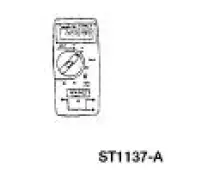Ford Mustang (1999-2004) Service Manual: Starting System (Diagnosis and Testing)
Refer to Wiring Diagrams Cell 20 , Starting System for schematic and connector information.
Special Tool(s)
 |
Digital Multimeter 105-R0051 or equivalent |
 Starting System (Description and Operation)
Starting System (Description and Operation)
Starter Motor
The starter motor is a 12-volt unit that has the starter solenoid mounted on
the drive end housing and
functions as follows:
The current flows through the solenoid energizing coil unt ...
 Inspection and Verification
Inspection and Verification
WARNING: When servicing starter motor or carrying out other underhood
work in the
vicinity of the starter motor, be aware that the heavy gauge battery input lead
at the starter
solenoid is "electric ...
Other materials:
Electronic Pressure Control (EPC) Solenoid
Special Tool(s)
Gauge, Transmission Solenoid
Connectors
307-426
Removal
1. Remove the manual control lever. For additional information, refer to
Manual Control Lever
Shaft and Seal in this section.
2. CAUTION: Do not pull on the molded ...
Inflating your tires
Safe operation of your vehicle requires that your tires are properly
inflated. Remember that a tire can lose up to half of its air pressure
without appearing flat.
Every day before you drive, check your tires. If one looks lower than the
others, use a tire ga ...
Differential Case and Ring Gear
Special Tool(s)
2-Jaw Puller
205-D072 (D97L-4221-A) or
equivalent
Installer, Differential Side
Bearing
205-009 (T57L-4221-A1)
Step Plate
205-D016 (D80L-630-5) or
equivalent
...
